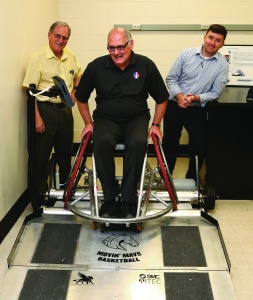
UTA’s wheelchair basketball players are on a roll – or eventually will be – and they didn’t even have to go off-campus to find a way to do it. Thanks to a persistent coach, a motivated professor and a crackerjack team of students, they will be equipped with a high-tech exercise machine tailored to their special needs.
The coach, Doug Garner, had for years used a machine – the equivalent of a treadmill – on which the wheelchair occupant powered a single roller, allowing measurement of speed and acceleration. The problem was that treadmills are powered by a single power source – the runner – whereas wheelchairs rely on two wheels.
What was needed, Garner says, was something “where we can monitor bilaterally which side is producing more power, so we can tell if there’s a weakness or if the person is pushing correctly so that both sides are pushing the same.”
Sounds like an engineering project, and where better to go than to UTA’s renown College of Engineering, specifically to Dr. Bob Woods. Intrigued, Woods offered the problem as an option for senior mechanical engineering students enrolled in the Capstone Project, a year-long class in which student teams design solutions during the fall semester and execute them in the spring.
So it was in the fall of 2018 that a six-man team headed by Brandon Griffin took up the challenge. “It was definitely our first choice,” he says. “The project looked like a good idea, and it also gave us the opportunity to get our hands dirty a little bit more than with the others.”
Many of the options, he explains, ended with analyses and computer simulations. “We chose this one because we knew we’d be able to actually build the machine,” he says.
It was actually the second attempt on the project, the first having fallen victim to a basic design flaw. That team based its solution on a normal wheelchair with wheels perpendicular to the ground. The wheels on sport chairs, however, are cambered, tilting outward from the chair in order to provide more stability on track or court.
“Obviously, we had to make the system so that it could accommodate what are called ‘day chairs’ with vertical wheels all the way out to your sports chairs, which are a lot wider,” Griffin says. “So, we had to deal with not only the width of the wheels, but also their diameter in placing the rollers.”
Woods describes the device as a “rolling exercise machine” with each wheel resting between separate front and rear rollers with electric motors attached to each set. “These motors are driven backwards and thus absorb power instead of generate it,” he says, “so the rider can adjust the resistance from no resistance to more resistance to a stall.”
Users can, via a computer screen, select between two modes – dyno and exercise.
Dyno begins as if the chair were traveling on a smooth, flat surface and then increases resistance until the wheels can’t move – great for measuring power and endurance. Exercise mode is more for workouts, with users able to control the amount of resistance.
Another innovation, Woods says, is a pneumatic lift system making it easier for a user to get a chair into place.
“This team really did well,” he says. “They were very professional, mature, understood the big picture, knew what to do and worked well together. I’m proud of them.”
Griffin took advantage of his status as team leader – and an early morning work session – to be the first to take a test ride. He arrived at the lab early one morning after the pneumatic parts had arrived to install them and couldn’t resist the urge to see if the system worked. “It was a good feeling to know that something I had designed and put together worked the way I intended it to,” he says.
The device has also been tested by three of Garner’s athletes, once during coverage by a local television station. “They liked it,” Woods says. “One of them even kind of used a rather explicit remark about how great it was while they were taping. They didn’t use that part on TV.”
Garner is likewise enthusiastic. “We’re really excited,” he says. “These guys are very intentional about working with us, the players, and a member of the kinesiology faculty to give us something usable – not a one and done, but something that can really help quality of life and sports performance.”
Garner and the players are eager for the device to take up residence in UTA’s Adaptive Sports Research Lab, but that may take a while. While Griffin’s team finished its work, their partner team of electrical engineering students did not complete the interface that will capture the data – speed, distance, acceleration, energy consumed – of the user. Unless some of the faculty decide to take a hand, that chore will be on next year’s project list.
That doesn’t diminish Griffin’s satisfaction. “Over three and a half or four years, in all these classes, you get exposed to the theory and fundamental understanding, but you never really get to apply it,” he says. “These capstone courses are a great way for you to take all that knowledge base and work toward a project. It was really great to be able to provide something these athletes could use.”

















